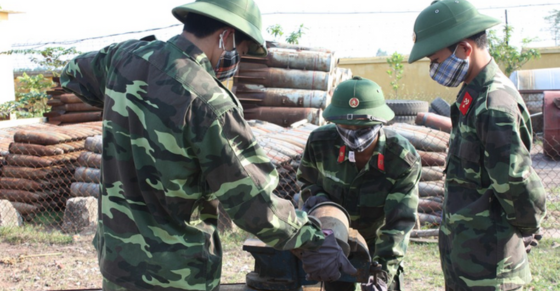Definition of Covid-19 cases under current regulations in Vietnam
Currently, how does the Ministry of Health define Covid-19 cases? What are the regulations on the definition of epidemic hotspots and the monitoring contents in Vietnam?

Definition of Covid-19 cases under current regulations in Vietnam (Internet image)
Definition of Covid-19 cases under current regulations in Vietnam
Content mentioned in Decision 3985/QD-BYT 2023 "Guidelines for monitoring and preventing COVID-19" issued by the Minister of Health.
1. Suspected cases (monitored cases) include:
Suspected cases are those with:
- Symptoms: fever and cough; or
- At least three of the following symptoms: fever, cough, headache, body ache - fatigue - chill; throat pain, runny or stuffy nose; reduction or loss of taste or smell; nausea, vomiting, diarrhea or difficulty breathing.
Suspected cases are those with severe acute respiratory infection (SARI) or severe viral pneumonia (SVP).
2. Confirmed cases (F0 cases):
- Confirmed cases are persons getting SARS-CoV-2 positive test results via genetic material detection testing (Realtime RT-PCR).
- Confirmed cases are persons mentioned in Section 1.1. and getting positive rapid antigen test results for SARS-CoV-2.
Definition of epidemic hotspots
1. Epidemic hotspot is an area where there are at least 02 cases with epidemiological connection*, at least one of which is the confirmed cases, Depending on the level of epidemiological connection, the scope of epidemic hotspots shall be determined as appropriate to reality (household/accommodation, household clusters, offices, classrooms or equivalent areas).
* Person meeting epidemiological criteria is a person who closely contacts with confirmed cases or is involved in cluster of confirmed cases
2. Inactive epidemic hotspot: An epidemic hotspot is considered inactive if no new cases are recorded after 8 days from the date on which the last confirmed case was detected and managed.
Monitoring contents in Vietnam
- Closely monitoring developments in the epidemic situation (new variants, unusual increase, etc.) in Vietnam and in the world to assess the epidemic situation.
- Collecting samples of the first 5-10 cases from places where there are many suspected cases to determine epidemic hotspots.
- Quickly collecting samples from people suffering from severe respiratory tract infection or people who are at higher risk of severity (the elderly, those with underlying conditions, including diabetes mellitus/ cardiovascular disease, those with immunodeficiency diseases and pregnant women).
- Integrating COVID-19 monitoring into the system for monitoring respiratory pathogen, including monitoring of influenza-like illness (ILI), monitoring of severe viral pneumonia (SVP) and monitoring of genetic characteristics of SARS-CoV-2 to monitor its variants.
Some information about COVID-19 in Vietnam
COVID-19 is an acute infectious disease caused by the SARS-CoV-2 virus. This virus mutates regularly, resulting in more infectious variants. According to monitoring results, Vietnam has recorded the majority of variants common in the world. The Omicron variant of SARS-Cov-2 is the most common variant in Vietnam and in the world at present.
SARS-Cov-2 directly spreads from human to human via the respiratory route (droplets are more common) and people’s hands when they contact by their hands with objects or surfaces infected with SARS-CoV-2, and then touch their eyes, noses or mouths. SARS-CoV-2 may also be transmitted via aerosols in closed and crowded spaces with poor ventilation or places where aerosol-generating operations are performed (including treatment facilities). Incubation period is approximately 04 days at present. COVID-19 patients can spread the virus to others over the period of from 2 days before their onset of symptoms to 3 days after the symptoms disappear. COVID-19 patients without symptoms may still shed the virus and transmit it to others.
Clinical manifestations of SARS-CoV-2 patients vary, ranging from no symptoms, mild symptoms to severe pneumonia, acute respiratory distress syndrome, sepsis and multiple organ dysfunction syndromes and death. People who are at higher risk of severity include the elderly, those with underlying conditions, including diabetes mellitus/cardiovascular disease, those with immunodeficiency diseases and pregnant women. Now, preventive vaccines and antiviral drugs for treatment are available.
On May 5, 2023, the World Health Organization (WHO) announced that COVID-19 no longer constitutes a public health emergency of international concern, but advised that countries still implement monitoring and prevention measures and make the transition from pandemic prevention to sustainable management.
More details can be found in Decision 3985/QD-BYT in 2023.
- Key word:
- Covid-19
- in Vietnam
- Number of deputy directors of departments in Vietnam in accordance with Decree 45/2025/ND-CP
- Cases ineligible for pardon in Vietnam in 2025
- Decree 50/2025 amending Decree 151/2017 on the management of public assets in Vietnam
- Circular 07/2025 amending Circular 02/2022 on the Law on Environmental Protection in Vietnam
- Adjustment to the organizational structure of the Ministry of Health of Vietnam: Certain agencies are no longer listed in the organizational structure
- Vietnam aims to welcome 22-23 million international tourists in Vietnam in 2025
-

- Emergency response and search and rescue organizations ...
- 10:29, 11/09/2024
-

- Handling of the acceptance results of ministerial ...
- 09:30, 11/09/2024
-

- Guidance on unexploded ordnance investigation ...
- 18:30, 09/09/2024
-

- Sources of the National database on construction ...
- 16:37, 09/09/2024
-

- General regulations on the implementation of administrative ...
- 11:30, 09/09/2024
-

- Notable new policies of Vietnam effective as of ...
- 16:26, 11/04/2025
-
.Medium.png)
- Notable documents of Vietnam in the previous week ...
- 16:21, 11/04/2025
-
.Medium.png)
- Notable documents of Vietnam in the previous week ...
- 16:11, 02/04/2025
-
.Medium.png)
- Notable new policies of Vietnam to be effective ...
- 16:04, 02/04/2025
-
.Medium.png)
- Notable new policies of Vietnam effective from ...
- 14:51, 21/03/2025

 Article table of contents
Article table of contents
